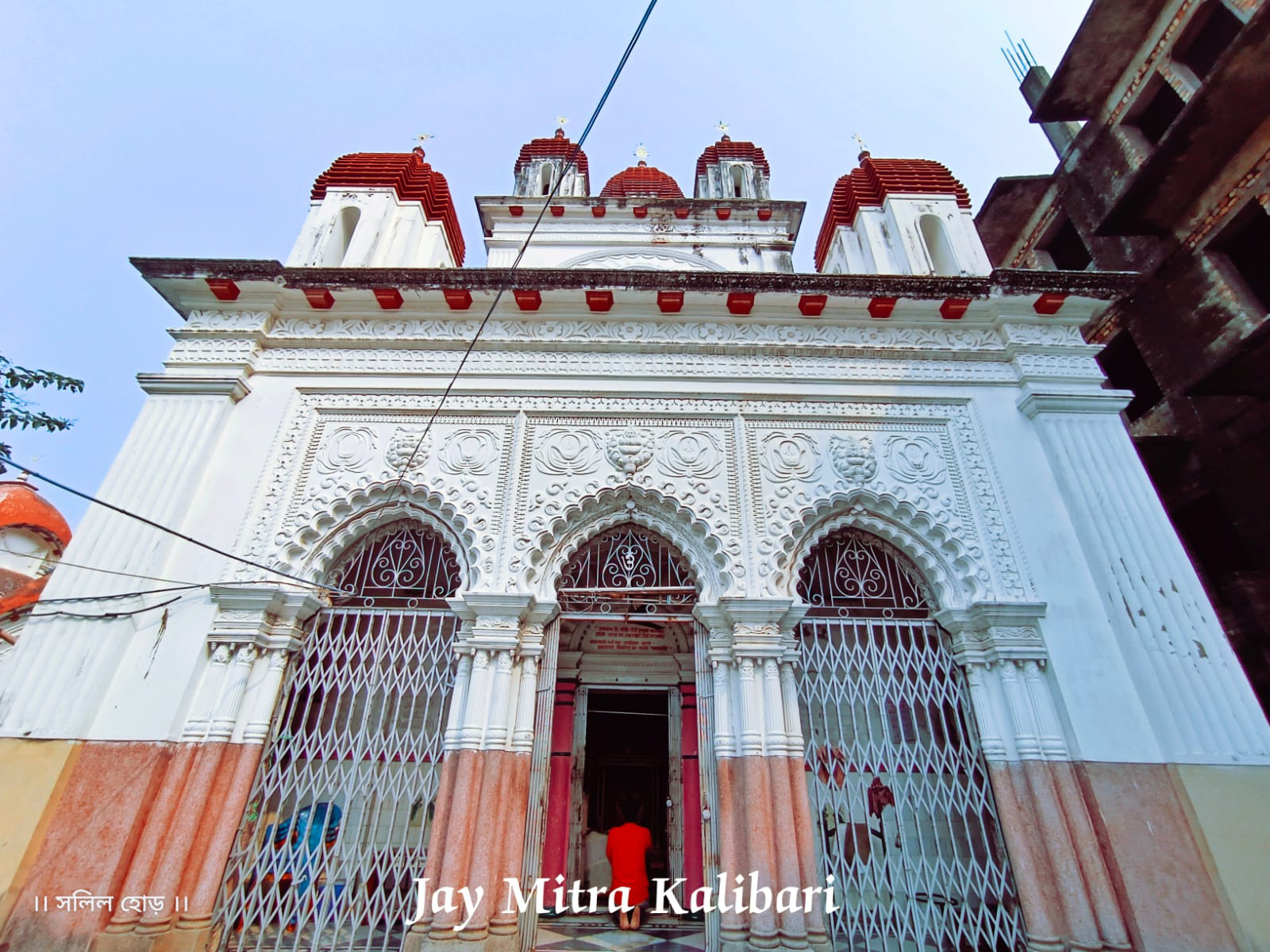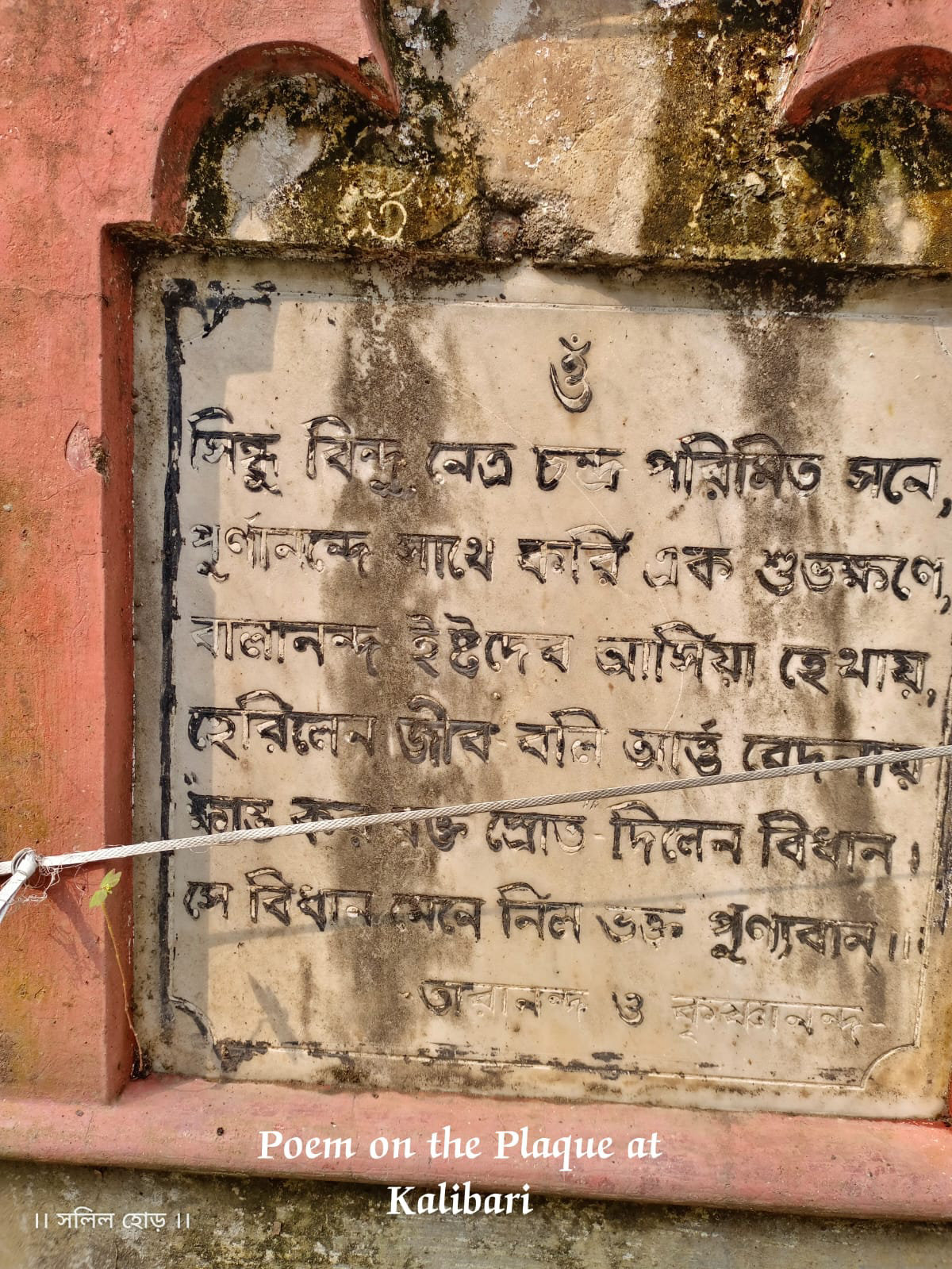গঙ্গার তীরে কালের সাক্ষী: বরানগরের কৃপাময়ী কালীবাড়ি (Witness to Time on the Ganges: The Kripamoyee Kalibari of Baranagar)
গঙ্গার শান্ত তীরে, কালের নীরব পদধ্বনির মাঝে মাথা উঁচু করে দাঁড়িয়ে আছে বরানগরের কৃপাময়ী কালীবাড়ি – যেন এক জীবন্ত ইতিহাস। একদা এই গঙ্গার ধারেই গড়ে উঠেছিল প্রতাপশালী জমিদার আর ধনকুবের বণিকদের বসতি। তাঁদের অনেকেই এই পবিত্র তীরে স্থাপন করেছিলেন দেবালয়, রচনা করেছিলেন উপাসনার শান্ত নীড়। সময়ের নিষ্ঠুর স্রোতে অনেক মন্দির কালের গর্ভে বিলীন হয়েছে, নয়তো অযত্নে ধুঁকছে। তবুও কিছু মন্দির আজও আপন মহিমায় উজ্জ্বল, প্রতিষ্ঠাতাদের বংশধরদের অক্লান্ত চেষ্টায় ফিরে পেয়েছে নতুন জীবন।
বরানগরের মালপাড়ার কুঠিঘাটে শান্ত স্নিগ্ধ পরিবেশে বিরাজমান কৃপাময়ী কালীবাড়ি তেমনই এক ঐতিহ্যপূর্ণ মন্দির প্রাঙ্গণ, যা বহু যুগের না বলা কথা নীরবে শুনেছে। এই মন্দিরের প্রতিষ্ঠা করেন শোভাবাজারের বিখ্যাত ধনাঢ্য ব্যক্তি জয়নারায়ণ মিত্র। তাঁর পিতা রামচন্দ্র মিত্র এককালে এক জাহাজ ক্যাপ্টেনের বেনিয়ান রূপে অগুনতি অর্থ উপার্জন করেছিলেন। সেই বিপুল ঐশ্বর্যের উত্তরাধিকারী জয় মিত্র প্রথাগত শিক্ষায় পণ্ডিত না হয়েও ব্যবসায়িক দক্ষতায় আরও সম্পত্তি বৃদ্ধি করেন এবং দানধ্যান ও সামাজিক কল্যাণে মুক্তহস্তে অর্থ দান করতেন। শোভাবাজারের পথ আজও তাঁর নামে মুখরিত – ‘জয় মিত্র ঘাট লেন’।
এই প্রভাবশালী ব্যক্তিত্ব জয়নারায়ণ মিত্র ১৮৫০ সালে, দক্ষিণেশ্বরের রাণী রাসমণির ভবতারিণী কালীমন্দির প্রতিষ্ঠার পাঁচ বছর পূর্বে, নয়টি চূড়া ও বারোটি আটচালা শিবমন্দির সমন্বিত এই কৃপাময়ী কালীবাড়ি স্থাপন করেন। প্রতিষ্ঠাতার শ্রদ্ধার্ঘ্য স্বরূপ এটি ‘জয় মিত্রের মন্দির’ নামেও পরিচিত।
কৃপাময়ী কালী মন্দির স্থাপত্যশৈলীর বিচারে ‘নবরত্ন’ নামে খ্যাত। মন্দির নির্মাণশাস্ত্রে ‘রত্ন’ হলো চূড়ার অপর নাম। সাধারণত, এই শ্রেণির মন্দিরে ঢালু ছাদ ও বাঁকানো কার্নিসের উপরে শোভা পায় একাধিক চূড়া। তবে কৃপাময়ী কালীর নবরত্ন মন্দিরের নির্মাণশৈলীতে রয়েছে অন্যান্য নবরত্ন মন্দির থেকে এক স্বতন্ত্র রূপ। এখানে চিরাচরিত বাঁকানো ছাদের পরিবর্তে দোতলা দালান মন্দিরের প্রতিটি তলে চারটি করে মোট আটটি এবং একেবারে শীর্ষে একটি বৃহৎ চূড়া স্থাপন করে নবরত্ন মন্দিরের বৈশিষ্ট্য দেওয়া হয়েছে। এছাড়াও, মন্দিরের স্তম্ভগুলি গুচ্ছবদ্ধভাবে ‘কলাগেচ্ছ্যা’ রীতিতে নির্মিত, যা অষ্টাদশ শতকে বাংলায় আসা ইউরোপীয় স্থাপত্যশৈলীর এক সুন্দর সংমিশ্রণ।
প্রাচীন এই মূল নবরত্ন মন্দিরটি আজও কালের আঘাত সহ্য করে তুলনামূলকভাবে ভালো অবস্থাতেই দাঁড়িয়ে আছে। কিছু বছর আগে মিত্তির পরিবার মন্দিরের কিছু অংশ এক প্রোমোটারের কাছে হস্তান্তর করেন, যার প্রতিদানে তিনি মন্দিরটির সংস্কার করেন। তবে এই আধুনিকীকরণের ছোঁয়ায় অনেক পুরনো স্মৃতিচিহ্ন হারিয়ে গেছে অথবা অযত্নে পড়ে রয়েছে। মন্দিরের বাম দিকে একটি শ্বেতপাথরের ফলকে খোদাই করা একটি কবিতা নীরবে তার গভীর অর্থ বহন করে চলেছে।
বর্তমানে মন্দিরের গায়ে লেগেছে নতুন রঙের উজ্জ্বল প্রলেপ। তবে ত্রিখিলান যুক্ত প্রবেশপথে ‘কলাগেচ্ছ্যা’ রীতির স্তম্ভগুলির সংস্কারে আনাড়ি হাতের ছাপ স্পষ্ট। দোতলার ছাদের কোণে থাকা ছোট রত্নমন্দিরগুলির অবস্থাও সেই একই রকম। মন্দিরের সম্মুখে এককালে এক বিশাল নাটমন্দির মাথা উঁচু করে দাঁড়িয়ে ছিল, যার ছাদ কালের ঝড়ে ভেঙে পড়েছে বহু আগেই। কেবল কয়েকটি গোলাকার থাম নীরব দর্শকের মতো টিকে ছিল। সম্প্রতি নাটমন্দিরটি নতুন করে নির্মিত হলেও, তা পুরনো স্থাপত্যের ঐতিহ্যের সঙ্গে একেবারেই বেমানান। নবরত্ন মন্দিরের পাশে, মুখোমুখি দুটি সারিতে ছয়টি করে মোট বারোটি আটচালা শিবমন্দির শান্তভাবে দাঁড়িয়ে। গর্ভগৃহে অধিষ্ঠিত শিবলিঙ্গগুলি ‘অমরনাথ’, ‘বৈদ্যনাথ’, ‘পশুপতিনাথ’, ‘চন্দ্রনাথ’, ‘ভুবনেশ্বর’ প্রভৃতি বিভিন্ন পবিত্র নামে পূজিত হন।
শ্রীরামকৃষ্ণ পরমহংসদেবের স্মৃতিবিজড়িত কলকাতার যে কয়েকটি স্থান আজ বিস্মৃতির অন্ধকারে তলিয়ে যেতে বসেছে, কৃপাময়ী কালী মন্দির তাদের মধ্যে অন্যতম। লোকমুখে শোনা যায়, শ্রীরামকৃষ্ণ দক্ষিণেশ্বরের ভবতারিণী কালীকে ‘মা’ এবং জয় মিত্রের কৃপাময়ী কালী ও অন্যান্য প্রামাণিক বিগ্রহকে ‘মাসি’ বলে সম্বোধন করতেন। দাঁইহাটের নবীন ভাস্করের নিপুণ হাতে নির্মিত এই তিনটি বিগ্রহের মধ্যে এক বিশেষ সাদৃশ্য আজও বিদ্যমান।
অতীতে এই মন্দিরে বিভিন্ন পূজা-পার্বণে লেগে থাকত এক আনন্দময় কোলাহল, বসত মেলা। তবে সময়ের পরিবর্তনে সেই জৌলুস আজ আর নেই। বর্তমানে নিত্যপূজা ও কালীপূজা অনুষ্ঠিত হলেও আগের সেই জাঁকজমক আজ অনুপস্থিত।
পরিশেষে বলা যায়, গঙ্গার তীরে নীরব প্রহরী রূপে দাঁড়িয়ে থাকা বরানগরের কৃপাময়ী কালীবাড়ি কেবল একটি ইটের স্তূপ নয়, এটি কালের এক জীবন্ত দলিল। বহু উত্থান-পতন, বহু পরিবর্তন নীরবে দেখেছে এই মন্দির প্রাঙ্গণ। প্রতিষ্ঠাতার অঢেল ঐশ্বর্য, কালের নির্মম অবহেলা এবং সাম্প্রতিক সংস্কার – এই তিনটি স্তর যেন এখানে একাকার হয়ে মিশে গেছে। হয়তো আগের সেই জৌলুস আর নেই, কিন্তু মা কৃপাময়ীর পবিত্র উপস্থিতি আজও ভক্তদের হৃদয়ে শান্তি ও ভক্তির অমৃতধারা বর্ষণ করে। এই ঐতিহ্যমণ্ডিত দেবালয়টিকে রক্ষা করা এবং এর অমূল্য ইতিহাসকে বাঁচিয়ে রাখা আমাদের সকলের পবিত্র কর্তব্য।
(English Version)
Witness to Time on the Ganges: The Kripamoyee Kalibari of Baranagar
On the tranquil banks of the Ganges, amidst the silent echoes of time, stands the Kripamoyee Kalibari of Baranagar – a living testament to history. Once, this very riverside was home to influential landlords and wealthy merchants. Many of them established temples along this sacred shore, creating peaceful havens for worship. While the relentless currents of time have swept away many temples into oblivion or left them languishing in neglect, some still shine in their glory, revitalized by the tireless efforts of their founders' descendants.
Nestled in the serene and gentle ambiance of Kuthighat in Malpara, Baranagar, the Kripamoyee Kalibari is one such heritage-rich temple complex that has silently witnessed the untold stories of bygone eras. This temple was founded by Joynarayan Mitra, a renowned and affluent figure from Shobhabazar. His father, Ramchandra Mitra, had amassed considerable wealth as a banian (a type of broker or agent) to a ship captain. Inheriting this vast fortune, Joy Mitra, despite not being formally educated, further augmented his wealth through astute business acumen and generously donated to charitable causes and social welfare. The streets of Shobhabazar still resonate with his name – ‘Joy Mitra Ghat Lane’.
This influential personality, Joynarayan Mitra, established this Kripamoyee Kalibari in 1850, five years before the consecration of Rani Rasmoni's Bhavatarini Kali Temple in Dakshineswar. The temple, featuring nine spires and twelve eight-roofed Shiva temples, is also known as ‘Joy Mitra's Mandir’ as a tribute to its founder.
Architecturally, the Kripamoyee Kali Temple is renowned as a ‘Navaratna’ (nine-jeweled) temple. In temple construction terminology, ‘ratna’ signifies a spire. Typically, temples of this style feature multiple spires atop sloping roofs with curved cornices. However, the construction style of the Navaratna temple of Kripamoyee Kali exhibits a distinct departure from other Navaratna temples. Here, instead of the traditional curved roof, a two-storied building incorporates a total of eight spires, four on each level, with a large central spire crowning the structure, thus embodying the characteristics of a Navaratna temple. Furthermore, the temple's pillars are clustered together in the ‘Kalagechhya’ style, a beautiful fusion of European architectural influences that arrived in Bengal during the 18th century.
This ancient original Navaratna temple has withstood the ravages of time and remains in relatively good condition. Some years ago, the Mittir family transferred a portion of the temple premises to a promoter, in exchange for the renovation of the temple. However, this modernization has led to the loss or neglect of many old relics. On the left side of the temple, a poem engraved on a white marble plaque silently conveys its profound meaning.
Currently, the temple walls are adorned with a fresh coat of vibrant paint. However, the amateurish touch is evident in the renovation of the ‘Kalagechhya’ style pillars at the triple-arched entrance. The condition of the small spire temples at the corners of the second floor's roof is similar. In front of the temple, a grand Natmandir (dance pavilion) once stood tall, but its roof collapsed long ago due to the storms of time. Only a few circular pillars remained as silent witnesses. Recently, the Natmandir has been rebuilt, but its new architecture clashes starkly with the temple's original heritage. Adjacent to the Navaratna temple, facing it in two rows of six each, stand twelve eight-roofed Shiva temples in serene composure. The Shivalingas (aniconic representations of Shiva) enshrined in the sanctums are worshipped under various sacred names such as ‘Amarnath’, ‘Vaidyanath’, ‘Pashupatinath’, ‘Chandranath’, and ‘Bhubaneswar’.
The Kripamoyee Kali Temple is one of the few places in Kolkata associated with the memories of Sri Ramakrishna Paramahamsa that are now fading into obscurity. Local lore suggests that Sri Ramakrishna referred to the Bhavatarini Kali of Dakshineswar as ‘Ma’ (Mother) and the Kripamoyee Kali of Joy Mitra, along with other authentic deities, as ‘Masi’ (Aunt). A remarkable similarity still exists among these three idols crafted by the skilled artisan Nabin Bhaskar of Daihat.
In the past, this temple used to be filled with joyous commotion during various festivals and pujas, and fairs were a common occurrence. However, with the passage of time, that splendor is no more. While daily worship and Kali Puja are still performed, the former grandeur is absent.
In conclusion, the Kripamoyee Kalibari of Baranagar, standing as a silent sentinel on the banks of the Ganges, is not merely a collection of bricks; it is a living document of time. This temple complex has silently witnessed numerous ups and downs, and countless changes. The founder's immense wealth, the relentless neglect of time, and the recent renovations – these three layers seem to have merged here. Perhaps the former glory is gone, but the sacred presence of Ma Kripamoyee still showers the nectar of peace and devotion upon the hearts of her devotees. Preserving this heritage-rich temple and its invaluable history is the sacred duty of us all.









Comments
Post a Comment